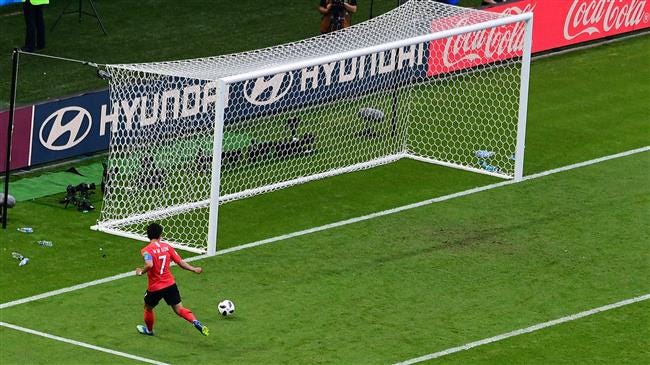Perusing World Cup Passing Data: Germany Part Two

It's not really breaking new ground to explain what went wrong with Germany's defensive game plan, it was essentially as obvious as eye testable things get on the biggest stage. Every weakness was exposed in the first half of their first game, Mexico's repeated breakaways were one of the standout memories of the World Cup. Now that you know the conclusion, let's go through the exciting details.
Germany had a ton of possession. They led the WC in shots per game, they were essentially pushing desperately for the entire second half of all three games and when that happens you rack up the possession. When you rack up the possession and are as good as Germany are, you can shut down some opponents pathways, especially with what we'd label a "high press." Germany wound up as one of the toughest to pass against in many clusters.*
*clusters are every pass broken up into 30 different "types" of pass for the WC

4 of the 10 "toughest" passes came against Germany. "toughest", "worst", "best" are all such wrong and odd words to use when talking about a tournament with so few games and such varying schedules but they still get most meaning across the simplest. Let's take a look at where those passes are:

When reading Mike Goodman's Arsenal preview at StatsBomb, I wondered how many front-tilted, high-possession teams would even be below-average at high pressing outside of Favre-ish teams purposely trying to avoid it. Germany for example were probably pressing well but they often had 7 guys in opposition half when possession started, quite easy to press then. Just to show you how tough it was to pass through them with those types of passes shown above, a graph:

Yes, the toughest. And it's not like the few completions they allowed with these types of passes led to much, only a few shots came within 30 seconds of a completion, well below WC average. If opponents started to break forward, it began to be flashing lights for the Germans. This next group of passes is what I'm calling the "midfield forward" passes. Yes, I know, the name rolls off the tongue, if I see anyone on Twitter steal it like the Ringer stole my poetically named and copyrighted "Deep Completions" I will be very displeased.


Not at the crazy Mexico levels (and look at Senegal at the top!) but not a good spot for Germany to be at. The team they play most similarly to: Spain, did not have this problem at all. They are 3rd from the top, under 3% of these type passes led to shots within 15 seconds while Germany was up above 8%.
Now we come to the payoff. Germany allowed fewer attempts of this pass than any other defense in the World Cup:

Now when you see this (and this will become clear in the video), try not to let this arrow get stuck in your mind as only example. It's a rough "type", there are only 30 total types so many different types of passes in this area can fit into this type.
Germany allowed just 13 of these passes in their 3 games. The average completion% on this pass is 67%, Germany allowed 12 of 13 passes to be completed. 22% of these passes turn into shots within 15 seconds, Germany allowed 8 (62%) to be turned into shots quickly.

These charts are pretty brutal reading for German fans (and also Mexican fans who had basically the same problems as Germany). Senegal is someone I'll have to look at next after the contrast between the forward middle (or was it middle forward, I'll have to copyright both) and then this final ball.
It's always better with video, so let's take a look at all of them from the South Korea and Mexico games (Sweden giving me technical difficulties).
[vimeo 284050698 w=640 h=360] <p><a href="https://vimeo.com/284050698">germanD</a>
Now you can see that one "type" of pass covers lots of different actual passes. When I see passing networks or pass maps, this is always a tough step to make conceptually and I falling into similar trap with clusters, especially such a small number for the WC, but wanted to make it clear. Anyway, you can see the momentum build and the defense begin to slip in many of these clips, it was sadly a familiar sight for German fans that will likely be seared into their memories. That's how despite their dominant way they shut down passes in their attacking half, they also wound up on the other list, the bad list.

Everyone came into this article knowing the German defense fell apart in the World Cup. Hopefully this article shows you in more detail what exactly happened and how bad it truly was. The head-of-steam, downhill attacks Germany repeatedly allowed started in midfield and just picked up until opponents often moved the ball through the left side for a high value shot. As long as they kept the lid on, their defense looked fine, elite even. But once one part of the lid popped, the rice was ruined and Mats Hummels was not looking happy.



